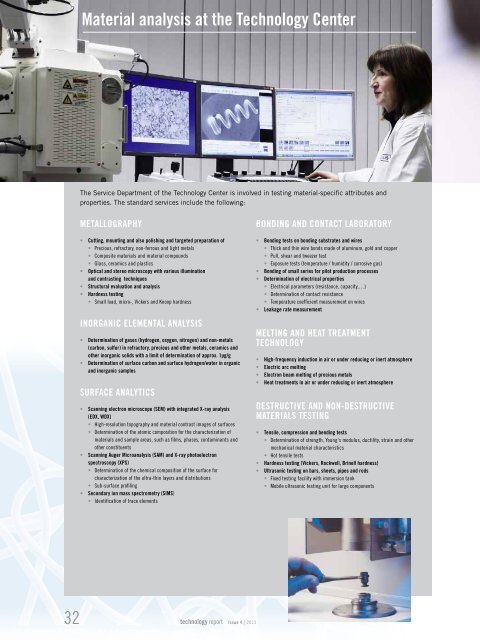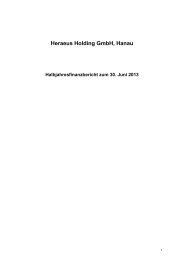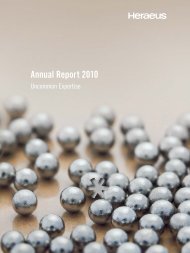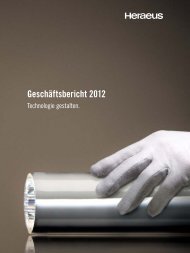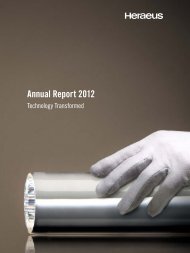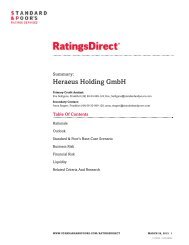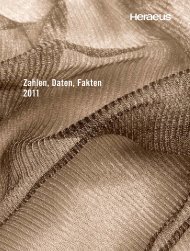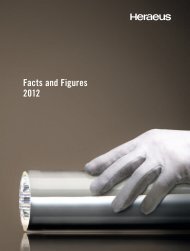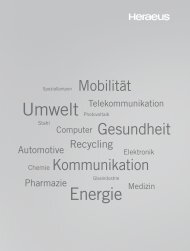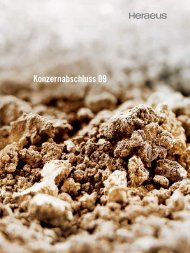technology report 04
technology report 04
technology report 04
Create successful ePaper yourself
Turn your PDF publications into a flip-book with our unique Google optimized e-Paper software.
Material analysis at the Technology Center<br />
The Service Department of the Technology Center is involved in testing material-specific attributes and<br />
properties. The standard services include the following:<br />
Metallography<br />
• Cutting, mounting and also polishing and targeted preparation of<br />
• Precious, refractory, non-ferrous and light metals<br />
• Composite materials and material compounds<br />
• Glass, ceramics and plastics<br />
• Optical and stereo microscopy with various illumination<br />
and contrasting techniques<br />
• Structural evaluation and analysis<br />
• Hardness testing<br />
• Small load, micro-, Vickers and Knoop hardness<br />
Inorganic elemental analysis<br />
• Determination of gases (hydrogen, oxygen, nitrogen) and non-metals<br />
(carbon, sulfur) in refractory, precious and other metals, ceramics and<br />
other inorganic solids with a limit of determination of approx. 1µg/g<br />
• Determination of surface carbon and surface hydrogen/water in organic<br />
and inorganic samples<br />
Surface analytics<br />
• Scanning electron microscope (SEM) with integrated X-ray analysis<br />
(EDX, WDX)<br />
• High-resolution topography and material contrast images of surfaces<br />
• Determination of the atomic composition for the characterization of<br />
materials and sample areas, such as films, phases, contaminants and<br />
other constituents<br />
• Scanning Auger Microanalysis (SAM) and X-ray photoelectron<br />
spectroscopy (XPS)<br />
• Determination of the chemical composition of the surface for<br />
characterization of the ultra-thin layers and distributions<br />
• Sub-surface profiling<br />
• Secondary ion mass spectrometry (SIMS)<br />
• Identification of trace elements<br />
Bonding and contact laboratory<br />
• Bonding tests on bonding substrates and wires<br />
• Thick and thin wire bonds made of aluminum, gold and copper<br />
• Pull, shear and tweezer test<br />
• Exposure tests (temperature / humidity / corrosive gas)<br />
• Bonding of small series for pilot production processes<br />
• Determination of electrical properties<br />
• Electrical parameters (resistance, capacity,…)<br />
• Determination of contact resistance<br />
• Temperature coefficient measurement on wires<br />
• Leakage rate measurement<br />
Melting and HEAT TREATMENT<br />
<strong>technology</strong><br />
• High-frequency induction in air or under reducing or inert atmosphere<br />
• Electric arc melting<br />
• Electron beam melting of precious metals<br />
• Heat treatments in air or under reducing or inert atmosphere<br />
Destructive and non-destructive<br />
materials testing<br />
• Tensile, compression and bending tests<br />
• Determination of strength, Young‘s modulus, ductility, strain and other<br />
mechanical material characteristics<br />
• Hot tensile tests<br />
• Hardness testing (Vickers, Rockwell, Brinell hardness)<br />
• Ultrasonic testing on bars, sheets, pipes and rods<br />
• Fixed testing facility with immersion tank<br />
• Mobile ultrasonic testing unit for large components<br />
32 <strong>technology</strong> <strong>report</strong> Issue 4 | 2013


